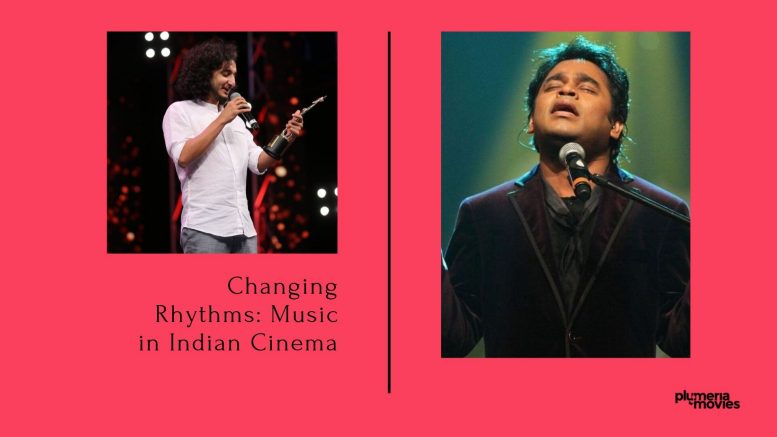Indian cinema is a very fertile breeding ground of musicians and lyricists. We have been blessed with numerous songs which continues to play on our lips, since generations. The patterns of the song visuals has been consistently transforming in our cinema. From the visuals crowded by groups of background dancers, from the miserable lip syncing by the heroes when they are lamenting their own father’s death, we have moved forward to situation oriented songs, and thankfully, less moments of lip sync. The funniest example of lip sync is the song ‘Pazham Thamizh paattizhayum’, from Fazil’s famous science fiction, Manichitrathaazhu.
Here, we see a doctor who has come to cure his friend’s problem with certain paranormal activities in his house, knowingly locking up another woman, presumable because he wanted to divert the attention of the real split personality affected patient. Like a cherry on top of the cake, he locks her up, sings a song, and lip syncs to it. Confusing the average audience, he lip syncs to the full song, even in instances where he ‘treats’ the fake patient. Thanks to a community of much more sensible filmmakers, we are not put through such heresy to our senses, any more.
This great change is a beginning. It marks the era of Indian cinema’s march towards a level beyond international films, at the level of visual and aesthetic quality. To take examples of films like Kumbalangi Nights, Varathan, Viswaasam, all belongs to the category of films which approach its song sequences with a fair aesthetic sense and logic.
AR Rahman
Another important yet subtle shift has been in the quality of music and lyrics of film songs. From a miserable period when South Indian film songs relied heavily on Bollywood genre of music, we have gradually moved on to an era where we have finally dug out our treasure – our classical instruments, our kind of music. Experiments with such exclusive music and international rhythms have given us legendary songs. A great contributor to such experiments is our own legend A R Rahman. It was at the peak time of Isaimaamani Ilayaraja, that a young musician entered the cinema industry. Like the Pied Piper, he lead us on from an exclusively classical music culture, to a music based on rhythm, almost tribal.
A R Rahman was one of those musicians who introduced us to a genre of music based on drums and beats – a kind of music with a tribal core – the perfect Dravidian mix of classical and international. His music was a trance. If you have noticed, compared to an Ilayaraja musical, A R Rahman’s creations are entirely based on a peculiar beat – a sort that has the drum beat as base. This might be the reason why we tend to groove unknowingly, when listening to A R Rahman. He has introduced us to magical qawwalis, gazals, and rare mix of classical and experimental music.
Sushin Shyam
After A R Rahman, I consider the young musician Sushin Shyam as the next landmark. His experience with numerous shows and his intense passion for music, makes his rhythms and beats, magical. He has been in the industry for a fairly long time, but the first song that made us search for the musician behind, was ‘Nee… ‘ from the movie Varathan. None of us may have stopped with this one song, and would have went on and listened to the rest of those tracks as well, from Varathan. Sushim Shyam’s music has that thing in it, which makes us do the head bang. Sushin Shyam is the face of Avant garde rhythm.
Indian cinema is gradually climbing that ladder when it comes to our music. We still have a long way to go, but the place we are at, now, is also beautiful. Let great musicians be born, and let them soothe our ears and souls with their rhythms. After all, who enjoys music as much as us. We have music in our souls, we take each beat we hear to our hearts, and we dance our way, around the world, taking it wherever we go.

A traveller at heart, writing is my art. Love is my God and this world is my home. Music is the drug and Cinema is the flame.


“അടി റാക്കമാ കൈയ്യെ തട്ട്” ഇളയരാജ ആണ്.
The author of this article has no clue about Rahman’s music or its dynamics or depth. With hardly peripheral knowledge about the characteristics ghat define his compositions, she has used his name in an article intended only as a promotional material for Sushin Shyam.
The audacity to authoritatively write such blunders is admirable 🤣
ഇളയരാജയെപ്പോലൊരു ഇതിഹാസം സിനിമാസംഗീത ഇൻഡസ്ടറി അടക്കിവാണിരുന്ന കാലത്ത് ഒരു പയ്യൻ മണിരത്നം പോലൊരു ലെജൻഡറി സംവിധായകനുവേണ്ടി സംഗീതസംവിധാനം ചെയ്യുക എന്നത് അക്കാലത്ത് ഒട്ടുമിക്കപേരും ശ്രദ്ധിച്ച കാര്യമാണ്. ഇളയരാജ അധികം പ്രാധ്യാനം കൊടുക്കാതിരുന്ന “ബേസിക് ബീറ്റ്” എന്ന സംഗതിയെ ശ്രദ്ധിക്കാൻ പാകത്തിന് ഉയർത്തി കേൾപ്പിച്ചത് അല്ലെങ്കിൽ, പാട്ടിന്റെ പ്രധാന ആയുധം ആ ബീറ്റ് ആക്കിയതായിരുന്നു ആ ചെറുപ്പക്കാരന്റെ ബ്രഹ്മാസ്ത്രം. “അടി റാക്കമാ കൈയ്യെ തട്ട്”-ൽ തുടങ്ങി “ഊർവ്വസി”യും “ചിക്കുപുക്ക് റൈലേ”യും ബ്രഹ്മാണ്ഡ ഹിറ്റ് ആയപ്പോൾ ജനങ്ങൾ അദ്ദേഹത്തെ ഇളയരാജയോടൊപ്പം പ്രതിഷ്ഠിക്കാൻ തീരുമാനിച്ചതിൽ തെറ്റൊന്നുമില്ലെന്നുള്ളത് കാലം തെളിയിച്ച സത്യം.
റഹ്മാന്റെ ചുവടുപിടിച്ച് ഒരുപാടുപേർ വന്നെങ്കിലും വിജു ഷായ്ക്ക് (ഗുപ്ത്) ശേഷം എന്നെ ഞെട്ടിച്ച ബീറ്റ് തന്ന ആളായിരുന്നു റെക്സ് വിജയൻ. ഏറ്റവും ഇഷ്ടപ്പെട്ട പാട്ടുകളിൽ ഒന്നാണ് “നോർത്ത് 24 കാതം” എന്ന സിനിമയിലെ “താനാരോ” എന്ന പാട്ട്. ഇന്റർനാഷണൽ ക്വാളിറ്റി ഉള്ള ഒരു പാട്ടാണ് അത്. റെക്സ് അങ്ങനെ മനസ്സിൽ നിറഞ്ഞുനിൽക്കുമ്പോൾ അതിനൊപ്പം ഞാനുമുണ്ട് എന്നുപറഞ്ഞു എന്റെ മനസ്സിലേക്ക് ദാ വരുന്നൂ ഒരാൾ. സുഷിൻ ശ്യാം. TDT എന്ന ബാൻഡ് അത് തുടങ്ങിയ സമയം മുതൽ ഇതാ “തട്ടത്തിൻ മറയത്ത്”-ലെ സ്ക്രൂ പയ്യൻ അല്ലേ എന്ന അറിവ് മാത്രമേ ഉണ്ടായിരുന്നുള്ളൂ. ഇപ്പോൾ അങ്ങനെ അല്ല, ബീറ്റ് വെറുതെ അങ്ങ് ഇട്ട് തിമിർത്തു മറിക്കുകയാണ്. തിയേറ്ററിൽ “വരുത്തൻ” കണ്ടപ്പോൾ എന്നെ ഫഹദിനും അമൽ നീരദിനുമൊപ്പം ഞെട്ടിച്ചത് സുഷിൻ കൂടിയായിരുന്നു. ഏത് പാട്ട് കേൾക്കുമ്പോഴും “ബീറ്റാണഖിലസാരമൂഴിയിൽ” എന്ന് വിശ്വസിക്കുന്ന എന്നെപ്പോലെ ഒരാൾക്ക് ഇവൻ റെക്സിന് ഒപ്പമാണ്. റഹ്മാന് പിൻഗാമിയാണ്. സുഷിൻ ശ്യാം.